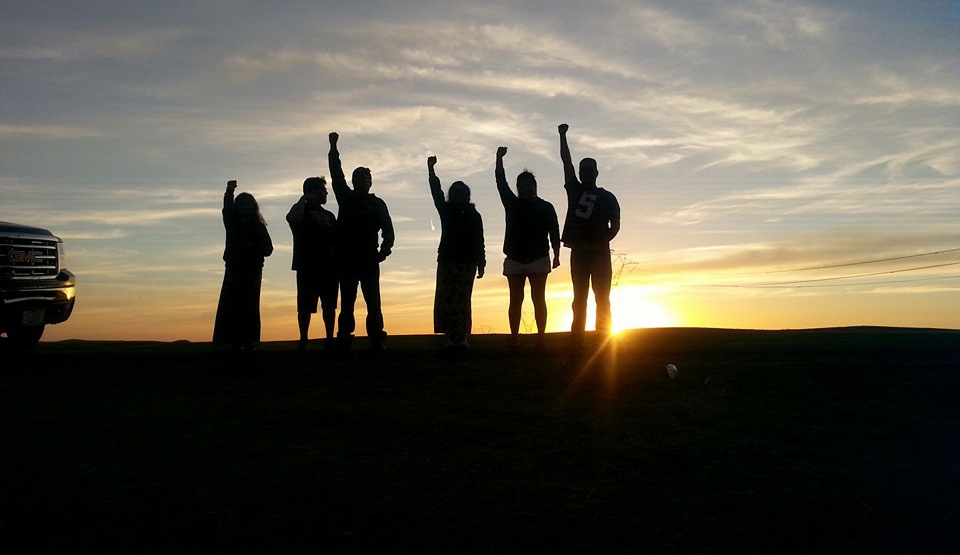In a brave showing of Indigenous solidarity and people-power, hundreds of tribal nations — including tribes from Wisconsin — have gathered near Cannon Ball, North Dakota in a collective effort to stop the construction of the Dakota Access Pipeline. The united actions of the tribal community — and the multiracial and multiethnic coalition of supporters — are not only shining a light on the new wave of environmental injustices our nation is facing, but through their resistance the broader public is getting a small glimpse at the systemic racism that Native Americans have long endured.
Since April of 2016, members of the Standing Rock Sioux Nation have gathered along the Missouri River to raise awareness about the Dakota Access Pipeline, and stop its construction. The pipeline is to be built just a half-mile from the Standing Rock Sioux Reservation — which is the sixth-largest Native American reservation in the country and home to over 8,000 Standing Rock Sioux people. Crossing through treaty-promised land — not only is the pipeline expected to run through sacred land, it could contaminate the reservation’s water supply. In fact, a spill would not only harm those on the reservation, but it could threaten humans, wildlife, and environments downstream.
As construction neared area just outside of the Standing Rock Sioux’s sovereign territory in August, the number of protestors grew to thousands — many representing hundreds of other tribal nations. As their numbers grew, the intimidation and force used by the construction company’s private security along with local and state law enforcement did as well. Additionally, powerful social institutions — such as the media and the justice system — operated in ways to subvert the growing mobilization by downplaying the events or creating false rhetoric about the people protesting. Local officials falsely reported the use of weapons by protesters and removed water trailers from the protest site. In early September, the private security hired by the construction company sent attack dogs into crowds of protestors — biting six people. The images captured during this encounter are said to be reminiscent of the Jim Crow era in our nation.
“The fight over the Dakota Access Pipeline is just beginning for the Standing Rock Sioux, so, too, are the battles by hundreds of tribes throughout our country that are asking that the federal government and state governments honor treaty rights that were guaranteed when Native Americans surrendered millions of acres of land and natural resources years ago.”
While the Obama Administration has temporarily halted construction of the Dakota Access Pipeline, the events that have played out near the Standing Rock Sioux Reservation should remind us that our country continues to operate using policies, practices, and ideologies which were adopted and historically used to marginalize, oppress, and kill Native American people and culture. Our nation’s institutional infrastructure continues to make it harder for Native voices to be heard, harder for Native Americans to legally defend their land and their rights, and harder for tribes to function as sovereign nations — something promised in treaties signed between tribes and the United States government.
To understand how systemic and institutional racism plays a role in the Standing Rock Sioux’s fight, take a look at the history of the tribe’s long battle with the U.S. Government to maintain the land that was rightfully, and legally, theirs. Through broken treaties and strategic laws, such as the Fort Laramie Treaty of 1851, government was able to gain land and jurisdiction over valuable resources like the Missouri River. The U.S. government, having sole jurisdiction over the land and resources, are required to do little consulting with the tribe before making decisions impacting that land and resources. In fact, if, and when, consulting is actually done between tribes, and the state and federal governments, there is nothing legally mandating that governments take tribal concerns into consideration. Therefore, even these consultative processes are often a façade.

Consequently, having jurisdiction over land and resources meant that the government had the power to reroute the original pipeline course from Bismarck (because there was too much of a concern that the pipeline could contaminate the water supply for the mostly white population — 92.4% as of the 2010 Census — of Bismarck) to an area only a half-mile away from the Standing Rock Reservation.
While we cannot simply press a master reset and right the wrongs of our nation’s history, or reverse the policies and procedures that have longed oppressed Native Americans and other communities of color, our current social, economic, and political context — whether it be the mass mobilizations under the banner of “Black Lives Matter” against the use of state apparatus like the police to enact violence, disproportionately, on citizens of color; the Latinx migrant workers in Familias Unidas Por La Justica (Families United for Justice) who are leading the next wave of labor struggle as they demand the right to fair pay, and dignity in their work; or the culminating of the largest gathering of Native American of 100 years in a valiant effort to defeat the “Black Snake” — indicates that the United States is at a pivotal moment in time and the future direction of our country is at stake. It is imperative that our nation begins the difficult and long overdue work, of correcting the mistakes of our past, and present, and taking a firm stance against the mistreatment of people of color. Reexamining how policies and procedures are disproportionately and adversely affecting communities of color must be done at all levels of government — whether its practices that expose communities of color to contaminated water or biases in our justice system.
The fight over the Dakota Access Pipeline is just beginning for the Standing Rock Sioux, so, too, are the battles by hundreds of tribes throughout our country that are asking that the federal government and state governments honor treaty rights that were guaranteed when Native Americans surrendered millions of acres of land and natural resources years ago.
In Wisconsin, where Native Americans face shocking racial disparities, protecting our state’s beautiful land and resources remain at the forefront. Right now, the Menominee Indian Tribe is fighting to stop the creation of a mine that could contaminate water and destroy sacred sites in northern Wisconsin. Several years back, the Bad River Tribe led the fight against the proposed mine in the Penokee Hills. In a state where John Muir and Gaylord Nelson are deeply admired and honored for their commitment to the land, let’s also remember and respect the first protectors of this land: our country’s Native people.










